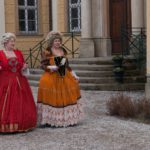Beneficjent: Fundacja Rozwoju Krajobrazu Kulturowego Dominium Łomnica
Tytuł projektu: Utworzenie Muzeum Dworu Śląskiego w Pałacu Łomnica, poprzez remont i przebudowę obiektu i utworzenie stałej wystawy
Wartość projektu: ponad 1.7 miliona zł
Wartość dofinansowania z UE: ponad milion zł
U stóp Karkonoszy, w Dolinie Pałaców i Ogrodów, zwanej też polską Doliną Loary, ulokowało się ponad 30 rezydencji – gotyckich zamków i wież obronnych, renesansowych dworów i barokowych pałaców. Wiele z nich odzyskało już dawny blask, tak jak Pałac Łomnica koło Jeleniej Góry, w którym teraz, dzięki dotacji z Unii, można było otworzyć Muzeum Dworu Śląskiego.
Po przeprowadzeniu kompleksowego remontu i przebudowy powstało nowoczesne muzeum, jeszcze jedna atrakcja turystyczna w Dolinie Pałaców i Ogrodów. Zwiedzający poznają historię regionu, sposób życia dawnych właścicieli i urzędników dworskich, zapoznają się z architekturą i sztuką wyposażania wnętrz. Muzeum zabierze gości w podróż w czasie do poprzednich epok m.in. poprzez produkcję filmów. W filmach będą przedstawione sceny prezentujące codzienne życie w pałacu na przestrzeni kilkuset lat. A wiele się wtedy działo! Historia Łomnicy sięga przecież XV wieku.
Jeszcze na początku lat 90. XX wieku łomnicka rezydencja przedstawiała się żałośnie: zawalony dach, zamiast okien dziury, teren wokół zaniedbany, park przetrzebiony. Mimo tego potomkowie Carla Gustava Ernsta von Küstera (rodzina Küsterów była ostatnim właścicielem dworu i mieszkała tu przez prawie sto lat aż do końca wojny), zdecydowali się kupić ruinę od Agencji Nieruchomości Rolnych i tchnąć w siedzibę rodową nowe życie. Zrobili remont, otworzyli restaurację i hotel, zadbali o park. Ważne było także podkreślenie tradycji tego miejsca, dlatego w pałacu organizowane były kiermasze świąteczne, na których sprzedawano wyroby lokalnych rzemieślników, a także prowadzone kursy gotowania tradycyjnych potraw.
Audycja o utworzeniu Muzeum Dworu Śląskiego w pałacu w Łomnicy, dzięki któremu można… przenieść się w czasie do poprzednich epok
Beneficiary: Foundation for the Development of Cultural Landscape Dominium Łomnica
Tittle: The creation of the Museum of the Silesian Manor in the Łomnica Palace, through the renovation and reconstruction of the building and the creation of a permanent exhibition
Project value: over1.7 million PLN
EU-co funding: over million PLN
At the foot of the Giant Mountains, in the Valley of Palaces and Gardens, also known as the Polish Loire Valley, there are more than 30 residences – gothic castles and defensive towers, Renaissance mansions and baroque palaces. Many of them have regained their former splendour, just like the Łomnica Palace near Jelenia Góra, where now, thanks to the funds from the European Union, the Museum of the Silesian Manor could be opened.
After a comprehensive renovation and reconstruction, a modern museum was created, which is yet another tourist attraction in the Valley of Palaces and Gardens. Visitors will learn about the history of the region, the way of life of former owners and court officials, as well as the architecture and art of interior decoration. The Museum will take visitors on a journey back to the previous epochs, e.g., through the production of films. The films will present scenes of everyday life in the palace over several hundred years. And quite a lot happened then! After all, the history of Łomnica dates back to the 15th century.
At the beginning of the 1990s, the Łomnica residence was pitiful: a collapsed roof, holes instead of windows, a neglected area around the property, a depleted park. In spite of this, the descendants of Carl Gustav Ernst von Küster (the Küster family was the last owner of the manor and lived here for nearly a century until the end of the war), decided to buy the ruins from the Agricultural Property Agency and breathe new life into the family property. They made a renovation, opened a restaurant and a hotel, and they took care of the park. It was also important to emphasize the tradition of this place, which was why Christmas markets were organized at the palace, where visitors could buy local craftsmen’ products, as well as take part in traditional cooking courses.
 Szukaj
Szukaj
















